Sky & Telescope and friends report on the total solar eclipse that occurred over Antarctica earlier this week.
An Antarctic Eclipse Adventure
Early morning on December 4th, a few thousand adventurous travelers crowded the decks of cruise ships, boarded specially chartered planes, or stepped out into Antarctica’s frigid air — all with their hearts thumping in anticipation of astronomy’s greatest spectacle: a total eclipse of the Sun.
The Moon’s narrow shadow reached Earth’s surface at a very oblique angle that day, creating a skinny but stretched-out oval of darkness over ground and sea. The shadow swept rapidly across the Southern Ocean, offering up to 1.9 minutes of totality in the frozen Antarctic terrain surrounding the Weddell Sea.
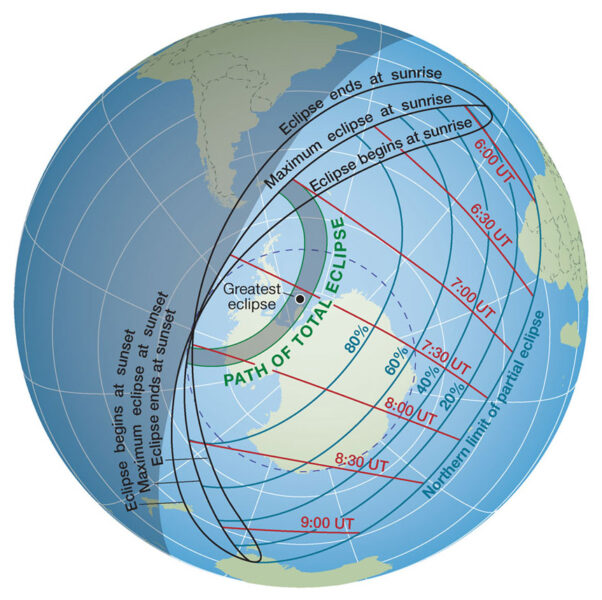
Sky & Telescope; source: Fred Espenak
December 4th’s event was unusual in two important respects. First, totality occurred in the most sparsely populated region of the entire planet. Land-wise, the path of the Moon’s dark shadow touched only Antarctica and the tiny South Orkney Islands as it swept across Earth. Only a few thousand people were positioned to see it. Meanwhile, the only inhabited places that got to see even a partial solar eclipse were on the southern tip of Africa, Tasmania, and bits of southeastern Australia and New Zealand’s South Island.
Second, the eclipse track mostly crossed the longitudinal hemisphere of Earth facing away from the Sun, during what would ordinarily be nighttime hours. However, because the event happened just a few weeks before the December solstice, the portions of Antarctica that lay within the path were experiencing constant daylight. Because of this unusual “over the pole” eclipse geometry, the Moon’s shadow didn’t sweep west to east in longitude, as it usually does, but instead raced east to west as it crossed Antarctica.

Judy Anderson
According to Jay Anderson, a Canadian meteorologist who specializes in eclipse-day weather, those on Antarctica had the best chance of seeing the eclipse, whereas the odds of success were against anyone venturing by ship to the accessible locations of the Southern Ocean.
In the end, the most daring eclipse-chasers — those who ventured to the outpost at Union Glacier in Antarctica (79°46′S, 83°16′W) — had the best views. From there, the gloriously eclipsed Sun sat 14° above the horizon at roughly local midnight, though viewers had to witness it in the brutal cold of late “spring,” near –20°C (–4°F).
Success also came for two groups of eclipse-junkies who took to the sky from Punta Arenas, Chile, aboard a pair of chartered 787 Dreamliners. The planes smoothly maneuvered into the path of totality at the cloud-free height of about 40,000 feet and offered unique views not only of the solar corona but also of the dark umbral cone surrounding it.
Yet even this seemingly straightforward gambit was fraught with complications, as international safety rules and a revoked landing permit forced the Chilean airline LATAM to save the expedition by providing a last-minute switch from smaller Airbus A321 aircraft to the longer-range (and much pricier) 787s.
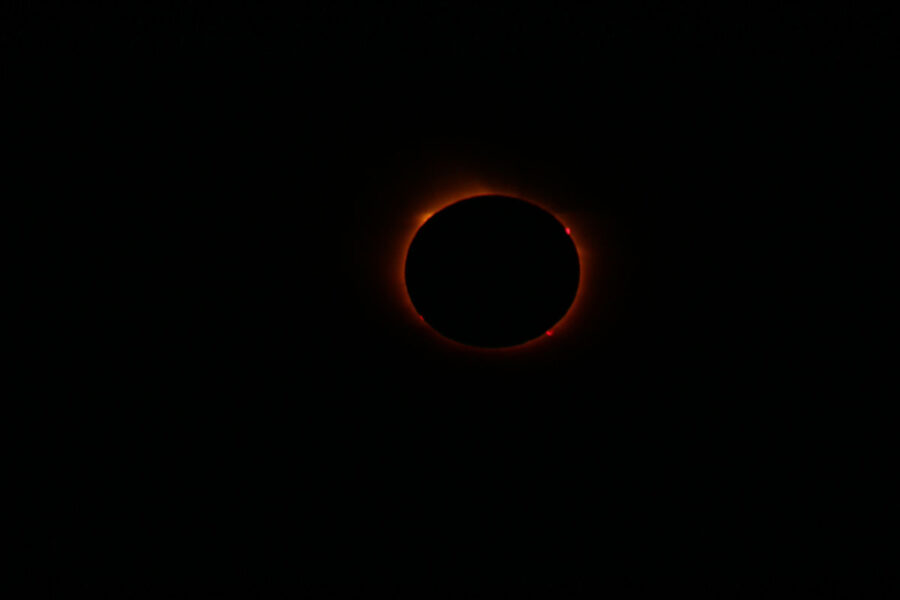
Judy Anderson
Meanwhile, down at sea level, a small armada of 15 expedition-class cruise ships had taken up positions within the umbral path in the hope of beating the poor-weather odds. One of those, Hurtigruten Expeditions’ ms Roald Amundsen, carried a Sky & Telescope group hosted by Contributing Editor Bob King.
Despite the maneuverability that such ships offer, mostly the clouds won out. Only one ship, National Geographic Endurance, caught sight of totality. Perhaps logically, this ship had Anderson and his wife Judy aboard.
“Oh, what a beautiful morning!!” exclaimed Judy Anderson afterward. “The crescent rose from the sea in a wedge of clear sky, and thinned rapidly to show the corona while the first diamond was visible at 2nd contact. . . . And all too quickly, the second diamond was there (flattened rather than brilliant cut!) and 3rd contact took us back to the thin crescent. Very, very shortly afterward, the tip of the crescent went into the looming bank of cloud. Phew!!”
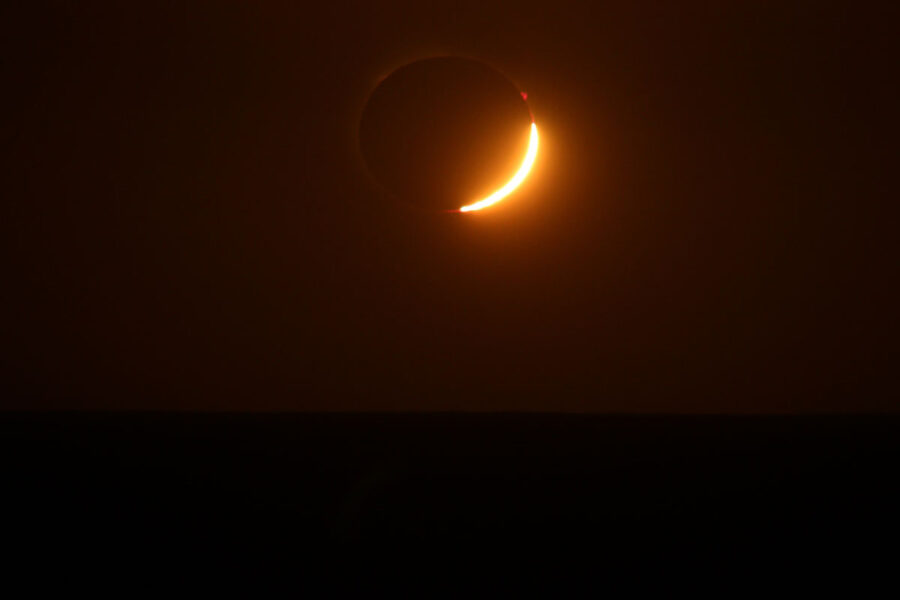
Judy Anderson
All those who ventured deep into the Southern Hemisphere for December 4th’s event will have to be patient to see totality again, as 2022 offers no total solar eclipses. The next one will be April 20, 2023, and will once again require a long journey: western Australia and Indonesia.
That event will be unusual in that it offers both an annular (ring) eclipse at the path’s ends, and up to 76 seconds of totality — what is sometimes termed a “hybrid” solar eclipse — in the middle. Hopeful eclipse-chasers will most likely be found in ships off the western and northern coasts of Australia (the path barely clips Australia itself at its northwesternmost corner), or perhaps on one of the islands of Indonesia.
— J. Kelly Beatty
Want to experience an eclipse like this? Check out our upcoming tours here!
High Hopes Clouded Over
Eclipse morning brought heavy clouds but high hopes. As skywatchers, we burn optimism like jet fuel until the moment the bill comes due. Our group began gathering on the 10th deck of the ms Roald Amundsen as early as 2:15 a.m. to assess weather and set up equipment.
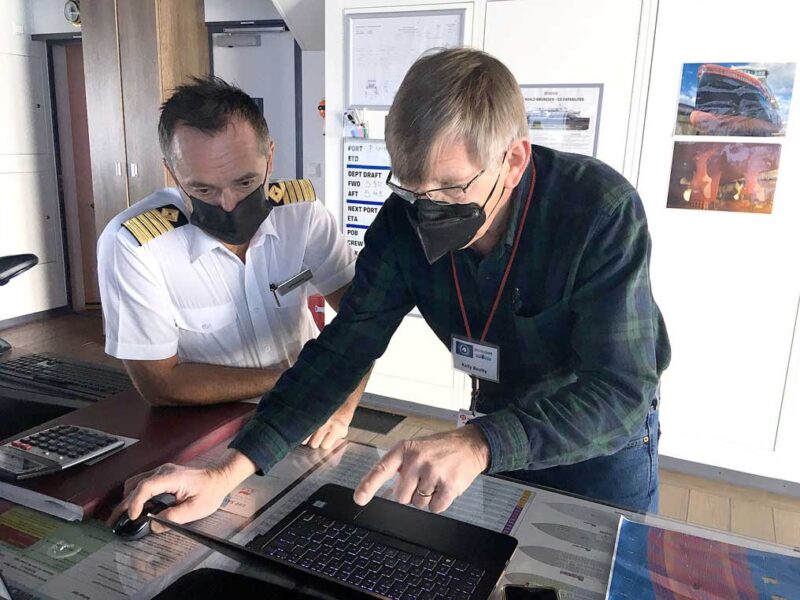
Bob King / Sky & Telescope
Frankly, things looked bleak in the gray twilight, but everyone busied themselves with cameras or talked about the prospects, secretly hoping to allay fate. There was always the chance that a hole might open in the marine layer overcast. In fact, around local sunrise at 2:40 a.m. I looked up, saw a hint of blue ,and remember telling someone that the coming Sun would burn off the clouds just in time.
Of course, that never happened. The eclipse began around 3:16 a.m., and as the overcast sky darkened, we all quietly realized we weren’t going to see this eclipse. It was at this moment that Kelly Beatty, Sky & Telescope senior editor and leader of the Sky & Telescope eclipse tour, injected some needed humor into our plight, announcing that it was “now safe to lower your solar filters.”

Bob King / Sky & Telecsope
But as it frequently does, the unexpected happened. I’ve been to six total eclipses with two clouded out and don't recall ever experiencing a darker eclipse or a faster-moving Moon shadow. In the final seconds before totality it felt as if an enormous black bird unfolded its wings and swooped down over the ship.
Undoubtedly, low clouds played a key role in intensifying the depth of the darkness but combined with the shadow's swift arrival, the scene made me shiver. Others must have felt the same because the steady chatter ebbed as daylight followed suit.
By the way, this was no imagined sensation of shadow speed but caused by a physical fact: the Moon's umbra hypersonically swept over us at 2.8 km per second (6,300 mph), from our location east of the centerline (58° 20ʹ south, 41° 19ʹ). After 1m 30s of occluded totality, the light returned so quickly I had the distinct sensation of opening my eyes — as if waking from a sleep — even though they were already open.
So, OK, I didn’t see the Sun, but I did experience the eclipse both physically and emotionally. And I’m going to the bank with that. Besides, there will always be another. Celestial mechanics guarantees success eventually, as long as you’re persistent.
— Bob King
Totality From Above the Clouds
As soon as I heard about an eclipse flight planned by “e-flight guru” Glenn Schneider, I signed up. Two Airbus A321 aircraft, chartered from LATAM Airlines, were to go almost due east from Punta Arenas, near the southernmost point of Chile, to catch the eclipse almost 4° above the horizon.
I was able to bring Williams College students Peter Knowlton (who had delayed graduation by a semester to be eligible) and junior Anna Tosolini. David Sliski (Penn State) joined us as a Research Associate to help bear responsibility for the students. Also in our group were Emma Sobel (Greenhill School), Nicole Massetti, and my wife, Naomi Pasachoff. This total solar eclipse would be my 36th and Naomi’s 22nd.
After reaching Santiago, we were surprised to learn that the flights had been threatened with cancellation the week before. Compliance with international aviation rules required a second landing place for the A321s in case of emergency, and the planned airports on the Falkland Islands had declined to accept us. So under that pressure, Tim Todd (TEI Travel) upgraded (at great expense) to a pair of LATAM’s Boeing 787 Dreamliners.
Our spectrography expert Aris Voulgaris (Thessaloniki, Greece) wasn’t happy about this, because the 787s have photochromic windows, which dim without shades, and looking through the particles in the window would blur images a bit. Also, the plane’s high wing required the pilot to turn a few degrees to the left just before totality, losing the image for a few seconds of our 1m 54s of totality. But we made do — we would have been canceled otherwise.
In the end, when the diamond ring finally came, the Moon’s shadow was clearly visible. All too soon, totality was over.
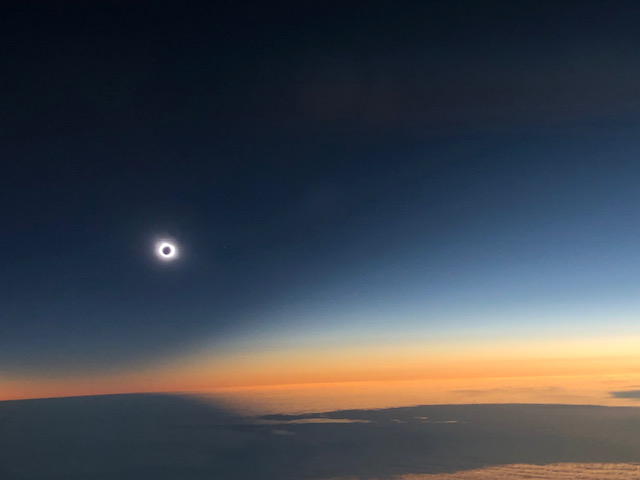
Photo by Jay Pasachoff / Williams College Eclipse Expedition / NSF Atmospheric and Geospace Sciences Division
Meanwhile, Williams alumnus Christian Lockwood, Theo Boris (Collegiate School) and a few others were on Union Glacier, part of a 10-day stay that earned them NSF Antarctica Service Medals.
Voulgaris’s images and spectra include red and green emission lines, evidence of the corona’s million-degree temperature. Using our science observations, we’ll also test pre-eclipse predictions from Predictive Science, made based on magnetic-field observations of the solar surface made with NASA’s Solar Dynamics Observatory. We hope to publish those results soon, as we did after 2017’s solar eclipse, in hope of improving astronomers’ understanding the Sun.
— Jay M. Pasachoff
 3
3









Comments
Bob-dBouncier
December 9, 2021 at 4:58 pm
Now that's what I call a cool eclipse!
You must be logged in to post a comment.
Yaron Sheffer
December 10, 2021 at 5:17 pm
"Moon’s shadow didn’t sweep west to east in longitude, as it usually does, but instead raced west to east" clearly meant to say "raced east to west".
You must be logged in to post a comment.
Weixelman
December 10, 2021 at 5:40 pm
Thanks for the reports! Nice to experience the eclipse vicariously! Looking forward to Australia perhaps in 2023.
You must be logged in to post a comment.
You must be logged in to post a comment.